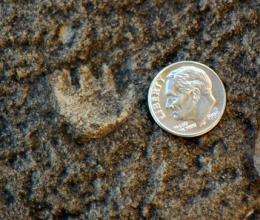Ancient mammal tracks found at national monument

(AP) -- Hundreds of tiny footprints left by mammals some 190 million years ago have been found on a canyon wall in a remote part of Dinosaur National Monument, park officials said Thursday.
The tracks are a rare find, mostly because they were left at a time when the area was a hostile, vast Sahara-like desert where towering sand dunes seldom preserved signs of animal life.
"It's just astonishing," Dan Chure, a paleontologist at the monument, said Thursday. "We were giggling like kids."
He and paleontologist George Engelmann of the University of Nebraska at Omaha spotted the tracks July 8 while scouring the area for fossils and other evidence from the early Jurassic period. Dinosaur National Monument, founded because of its rich and plentiful supply of dinosaur bones, straddles the Utah-Colorado border.
Most of the tracks are the size of a dime or smaller. A few include impressions of up to four toes. The mammals - perhaps the size of a rat - were among the few species that were able to survive between large sand dune fields where there was water, dinosaurs and a few plants, Chure said.
Because they were living in a forbidding desert environment, most animals probably came out at night, including the small mammals who left the tracks, Chure said. He said it's reasonable to assume the tracks were preserved by a layer of moisture that created a slight crust on the dune and kept the prints from blowing away.
There were likely once thousands more tracks in the area that have since been lost to erosion, Chure said.
Similar track sites have been found elsewhere, but Chure said he didn't know of any that had as many individual footprints.
It'll take more study to determine exactly what kind of mammal left the prints behind.
Interspersed among the mammal footprints are tracks from larger animals, possibly small dinosaurs, Engelmann said.
"This was a time when the ancestors of modern mammals were losing dominance on land to the dinosaurs," Engelmann said. "It's near the beginning of a long time when dinosaurs ruled and our ancestors tried to stay out of the way."
Park officials aren't disclosing the exact location of the sandstone canyon wall where the tracks were found because of concerns about vandalism. The area where the tracks were found is open to the public.
The next steps will include mapping and counting the tracks and creating a cast that can be displayed at the monument's visitor center, Chure said.
The monument, which celebrates its 100th anniversary this summer, is best known for hosting the nation's premier quarry of Jurassic-period bones, some 1,500 of them.
The newly found mammal tracks predate the bones at that site by 40 million to 50 million years, Chure said.
---
On the Net:
Dinosaur National Monument: http://www.nps.gov/dino
©2009 The Associated Press. All rights reserved. This material may not be published, broadcast, rewritten or redistributed.
















